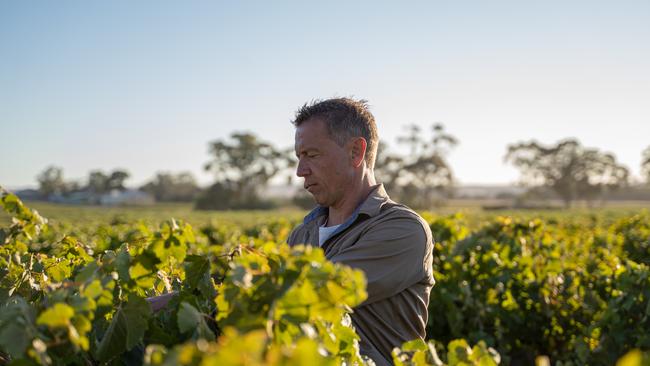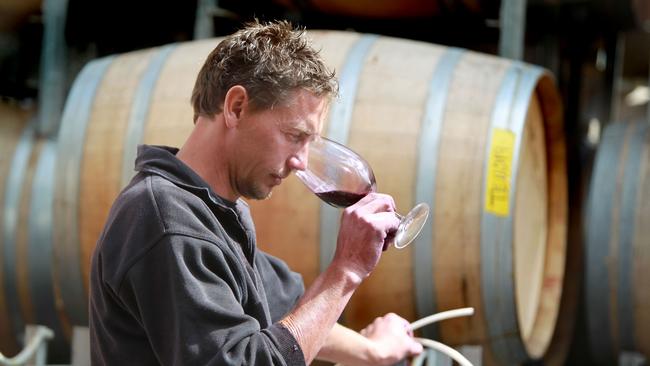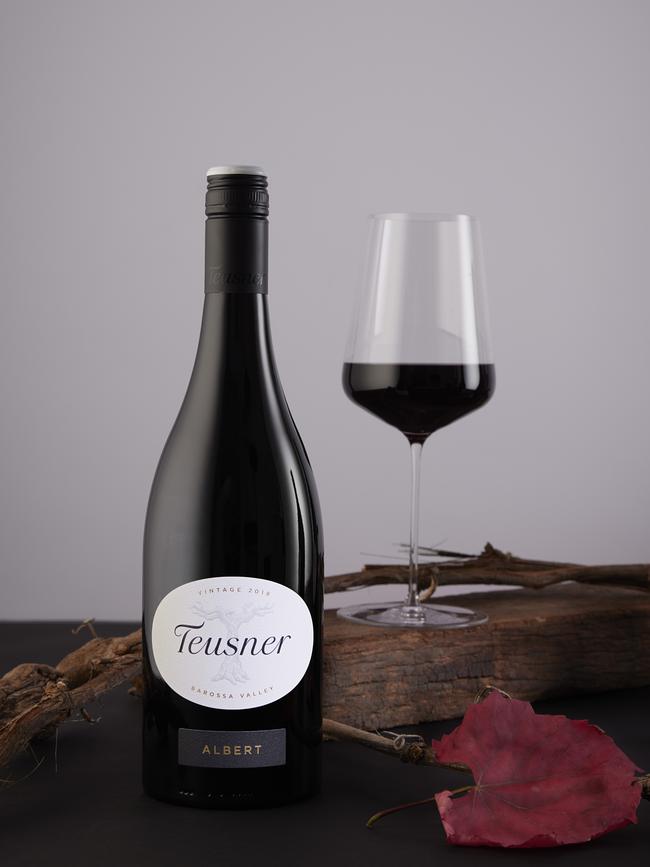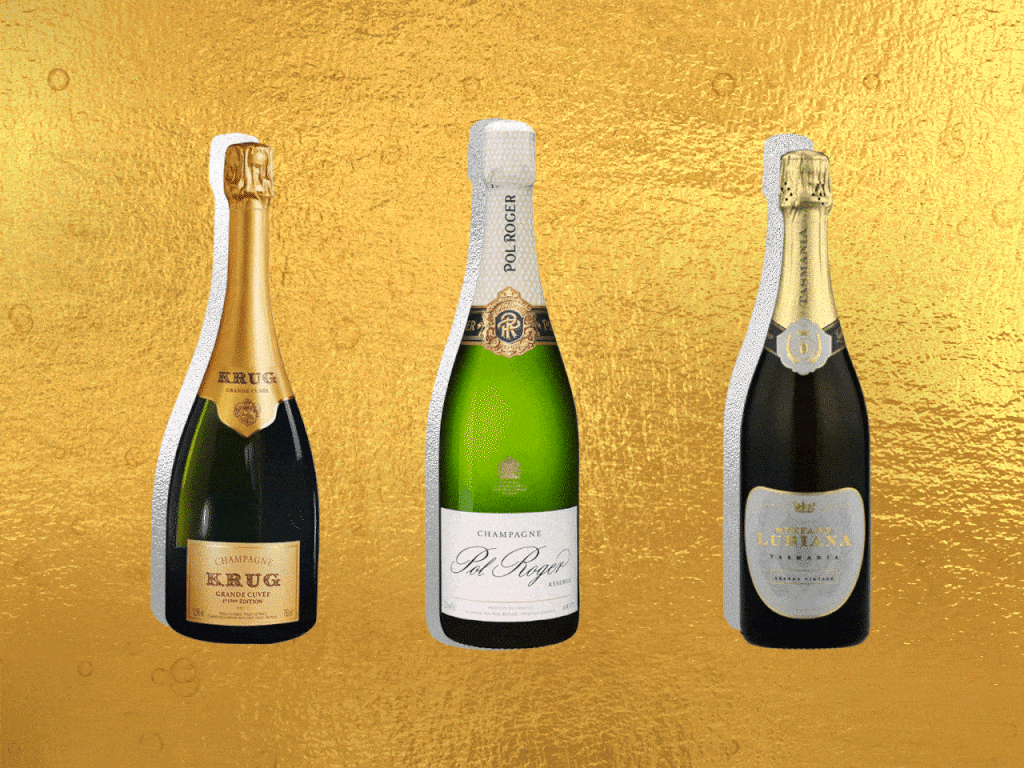Kym Teusner’s 20-year journey from Barossa novice to James Halliday’s Top 100
The Australian Wine Club is offering a mixed dozen from James Halliday’s Top 100 - including a 99-point sensation - for $27.99 a bottle. Find out more.

Kym Teusner’s heart sank when he tried his first wine. All the young winemaker could smell and taste from the first batch of fermenting grapes he’d purchased himself was menthol. Menthol and mint and eucalyptus and … bloody menthol. Where was the fruit? Where were those dark berry flavours that had made Barossa shiraz famous around the world?
“I thought I’d done my money before I even got started,’’ he says.
It was vintage 2002 and Teusner, a sheep farmer’s son who couldn’t bear the thought of becoming a sheep farmer, was facing his moment with destiny.
At 28, he had already navigated a twisting road on the way to this ferment: leaving the family home after high school, business management studies in Adelaide, years of working in hospitality, falling in love with Barossa reds (and a Barossa girl), studying winemaking, jobs at Barossa Valley wineries – and, now, taking the plunge into his own venture, with his own name on the label.
Hard-won savings of around $40,000 had been spent buying these old-vine shiraz grapes. He had precious little other money lying around. “I couldn’t do much more but to throw the wine into tightly grained French [barrels] and wait,’’ Teusner says.
DETAILS OF THE AUSTRALIAN WINE CLUB OFFER BELOW
But as the months passed, his spirits began to lift: “Gradually the menthol subsided and other flavours came through – characters like charcuterie and truffle and spices – and I began to really like it.”

That gut-wrenching ride of a ferment was the birth of the Teusner winery and its Albert Shiraz, named after the winemaker’s grandfather. Fast-forward 20-odd years and the 2021 Albert has scored a near-perfect 99 points in the 2023 Halliday’s Top 100, published in The Weekend Australian Magazine.
As it turned out, Albert was at the vanguard of a newly styled Barossa shiraz: slightly lighter and more savoury and complex than the concentrated fruit-driven old-school classics.
“If you looked at that wine blind, I reckon you’d struggle to say it was from the Barossa,” Teusner tells me. “It has power but not heavy power. These wines are more of a medium-bodied style, more about aromatics and complexity, more European; less about dense, concentrated impact.”
(His winery also creates a more traditional, blockbuster-styled shiraz called the Teusner Righteous ‘FG’ Shiraz, which ended up in the hands of Barack Obama during one of his presidential visits to Australia.)

As Teusner took his first steps out on his own, he found himself among a new generation of Valley winemakers emerging around the same time. The young guns were taking over the winemaking mantle from masters like Peter Lehmann, Wolf Blass, Charles Melton, Grant Burge and Chris Ringland and authoring a new chapter in the Barossa story.
Names like Pete Schell at Spinifex, Sons of Eden’s Corey Ryan and Simon Cowham, Laughing Jack’s Shawn Kalleske, 1850 grenache custodian Marco Cirillo, Jaysen Collins and Dan Standish at Massena and Standish Wine Co, Smallfry’s Wayne Ahrens, Eperosa’s Brett Grocke and Damien Tscharke and Jason Schwarz with their eponymous named ventures. Their more refined, less interventionist winemaking style was a counter-reaction to the big, concentrated, fruit-bombs that caught the attention of America’s most influential wine critic of the 1990s, Robert Parker Jr.
Parker’s Wine Advocate handed out 100-point scores to the biggest, juiciest fruit bombs, turning America on to the unadulterated joys of Barossa juice and making fortunes for those winemakers happy to follow the style guide.
Unfortunately, the biggest, most concentrated fruit-bombs aren’t renowned for ageing gracefully (not enough acid left in the fruit) and soon America’s palate moved on. What was “in” was suddenly “out”.
Teusner was sitting in a Valley pub with his brother-in-law Mick Page when they overheard a couple of grape growers weighing up bulldozing their 85-year-old grenache vines. “We offered about twice as much as they’d been paid by the big guys for the crop if they’d keep the vineyard in the ground,’’ he says.
Paying over the odds for this grenache, along with the old-vine shiraz that created the first Albert, may not have been financially shrewd for a cash-strapped winemaker trying to start his own business but it was hardly an act of naivety.
“Growing up on the farm, where we grew cereal as well as ran sheep, I always thought it was absolutely ridiculous that we would never know what we would be paid for our crop until after we had grown it – I didn’t like that,’’ Teusner says. “That’s why I probably paid more back then.”
Teusner understands that the work of grape growers is as integral to the quality of wine as that of winemakers: “They’re paid well because not only do they work hard but they’re extremely good at what they do.”
As the vintages stacked up behind him, Teusner also learned that creating wines with both complexity and power is “as much about site selection as winemaking”.
The Albert is still made from the same vineyard as supplied those first grapes in 2002 – 65-year-old vines planted in Ebenezer in the Barossa’s north, owned by the Riebke family for six generations. Grapes from another vineyard in Barossa’s southeastern most extremity at Williamstown provide the other portion of the blend. “Beautiful aromatics come from the Ebenezer grapes while the Williamstown fruit puts the stuffing in the backend – the palate weight and richness,” he says.
The Teusner winery produces around 30,000 dozen each year and is widely regarded as one of the Barossa’s leading lights.
“In those early times, we pretty much doubled the business each year – mortgaged the house twice. It was pretty stressful but we never had much to lose so we gave it all we had,’’ says Teusner. “But the environment now for the wine industry is as difficult as I’ve ever seen it … Covid, China, wars, interest rates on the rise, cost-of-living pressures … it’s a perfect storm.
“We’re holding our ground; our brand is strong. I think people have faith that if they pick up a bottle of Teusner, it won’t leave them feeling short-changed. That’s really what we’ve worked towards over the years.”
The Australian Wine Club is offering a mixed dozen from James Halliday’s Top 100, made up of two bottles of each of these six beautiful wines for $27.99 a bottle. Here’s the line-up.
Teusner Albert Barossa Valley Shiraz 2021: Perfect example of modern Barossa shiraz: fragrant, silky and elegant. Fresh plums, boysenberry and spice, with a meaty complexity.
- 14.5% alc
- RRP $70
- 99 points
Sidewood Estate Adelaide Hills Shiraz 2022: Cool climate shiraz from an Adelaide Hills star. Dark plums, blackcurrant and bitter chocolate. Silky and seamless.
- 14% alc
- RRP $26
- 96 points
Bleasdale Frank Potts Langhorne Creek Cabernet Blend 2021: Red berry and dark fruit flavours in a perfectly balanced package. Complexity well beyond the price point.
- 13.5% alc
- RRP $39
- 97 points
Hay Shed Hill Chardonnay 2022:
Elegance par excellence from one of Margaret River’s oldest vineyards: freshly cut pears, honeydew melon with some zesty notes. Crisp acidity.
- 12.5% alc
- RRP $27
- 97 points
Kerrigan + Berry Great Southern Riesling 2023: A gold-medal example of the intense citrus flavours and electric acidity that mark the best Great Southern rieslings. From a 50-year-old vineyard in Mt Barker. Juicy, steely with a long refreshing finish.
- 12% alc
- RRP $30
- 94 points
Coriole McLaren Vale Piquepoul 2023: Fresh lemons, citrus blossom and white nectarines, backed by zippy acidity. Oysters please!
- 11.8% alc
- RRP $28
- 93 points
SPECIAL OFFER
Order online or telephone 1300 765 359 Monday to Friday, from 9am to 5pm AEST. Deals are available only while stocks last.





To join the conversation, please log in. Don't have an account? Register
Join the conversation, you are commenting as Logout